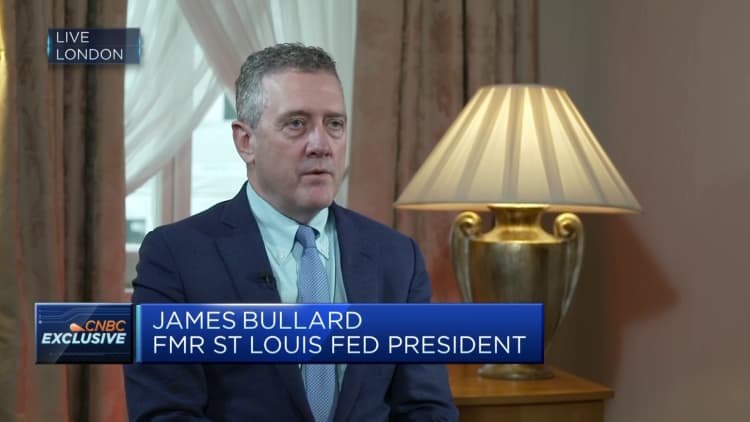Former St. Louis Fed President Jim Bullard says the Federal Reserve still has "a ways to go" in fighting inflation and that there is still a risk that prices pick up once again.
Between March 2022 and July 2023, the FOMC enacted a run of 11 rate hikes to take the fed funds rate from a target range of 0.0%-0.25% to 5.25%-5.5%, and inflation has since fallen substantially.
Although markets now believe interest rates have peaked and have begun looking forward to cuts next year, Bullard — who stepped down as head of the St. Louis Fed in August — suggested the central bank's work is far from over.
"It's been so far so good for the FOMC. Inflation has come down, core PCE inflation on a 12-month basis down from 5.5% to 3.7% — pretty good but that's still only halfway back to the 2% target so you've still got a ways to go," he told CNBC's Joumanna Bercetche on the sidelines of the UBS European Conference in London.
"I think you have to watch the data carefully and it's very possible that inflation will turn around and go the wrong way."

October's consumer price index slated for release Tuesday is expected to show an increase of 0.1% month on month and 3.3% annually, according to a Dow Jones poll of economists.
"That's just one month's number, but still I think the risk for the FOMC is that the nice disinflation that we've seen over the last 12 months won't persist going forward and then they'll have to do more," Bullard said.
On growth, Bullard said the risk of a U.S. recession next year is only around 15% at present, and suggested the baseline case should be that growth will remain at trend pace while inflation continues to fall, yielding a "soft landing."
"One thing about recessions is there have only been four in the last 40 years — that's about one every 10 years — and they're very hard to predict," he said.
"None of those four were predicted ahead of time, so one way to think about that is that recessions are caused by shocks and the shocks are inherently unpredictable, so the baseline should probably not be a recession for 2024, even though it's a possibility."
Correction: Between March 2022 and July 2023, the FOMC enacted a run of 11 rate hikes to take the fed funds rate from a target range of 0.0%-0.25% to 5.25%-5.5%. An earlier version misstated the range.

